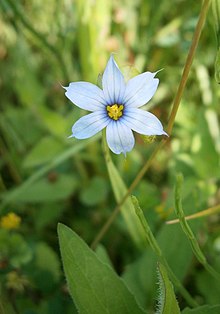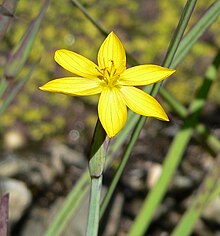
Sparaxis is a genus of flowering plants called the harlequin flowers. It belongs to the iris family Iridaceae with about 13 species endemic to Cape Province, South Africa.

Freesia is a genus of herbaceous perennial flowering plants in the family Iridaceae, first described as a genus in 1866 by Christian Friedrich Ecklon (1886) and named after the German botanist and medical practitioner, Friedrich Freese (1795–1876). It is native to the eastern side of southern Africa, from Kenya south to South Africa, most species being found in Cape Provinces. Species of the former genus Anomatheca are now included in Freesia. The plants commonly known as "freesias", with fragrant funnel-shaped flowers, are cultivated hybrids of a number of Freesia species. Some other species are also grown as ornamental plants.

Iridaceae is a family of plants in order Asparagales, taking its name from the irises. It has a nearly global distribution, with 69 accepted genera with a total of c. 2500 species. It includes a number of economically important cultivated plants, such as species of Freesia, Gladiolus, and Crocus, as well as the crop saffron.

Libertia is a genus of monocotyledonous plants in the family Iridaceae, first described as a genus in 1824. It is native to South America, Australia, New Guinea, and New Zealand. Eight species are endemic to New Zealand.

Olsynium douglasii is a species of flowering plant in the iris family (Iridaceae). Common names include Douglas' olsynium, Douglas' grasswidow, grass-widow, blue-eyed grass, purple-eyed-grass, and satin flower, It is the only species in the genus Olsynium in North America, the remaining 11 species being from South America. It was formerly treated in the related genus Sisyrinchium. Despite the common names, it is not a true grass (Poaceae).

Olsynium is a genus of summer-dormant rhizomatous perennial flowering plants in the iris family Iridaceae, native to sunny hillsides in South America and western North America.

Sisyrinchium montanum, the blue-eyed-grass, American blue-eyed-grass, or strict blue-eyed grass, is a grass-like species of plant from the genus Sisyrinchium, native to northern North America from Newfoundland west to easternmost Alaska, and south to Pennsylvania in the east, and to New Mexico in the Rocky Mountains. It has also been introduced to parts of France, likely during the First World War.

Orthrosanthus is a genus of flowering plants in the family Iridaceae first described as a genus in 1827. It is native to Australia, Mexico, Central and South America.

Dierama is a genus of flowering plants in the family Iridaceae. Common names include hairbells, angel's fishing rod, fairybells, and wandflowers in English and grasklokkies in Afrikaans. They are native to Africa, with most occurring in the southern regions of the continent. The center of diversity is the province of KwaZulu-Natal in eastern South Africa.
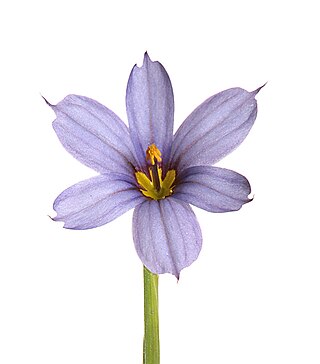
Sisyrinchium angustifolium, commonly known as narrow-leaf blue-eyed-grass, is a herbaceous perennial growing from rhizomes, native to moist meadow and open woodland. It is the most common blue-eyed grass of the eastern United States, and is also cultivated as an ornamental.
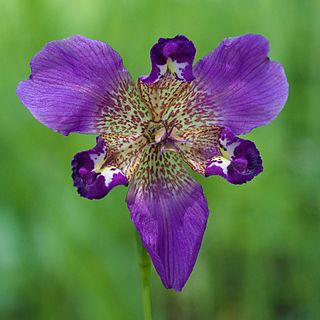
Alophia is a small genus of perennial, herbaceous and bulbous plants in the family Iridaceae. The genus comprise five known species that occur from the South-central United States as well as in Mexico, Central America, and parts of South America.
Cyanixia is a genus of plants in the Iridaceae, first described in 2003. It contains only one known species, Cyanixia socotrana, a perennial, herbaceous and bulbous plant species endemic to the Island of Socotra in the Indian Ocean, part of the Republic of Yemen.
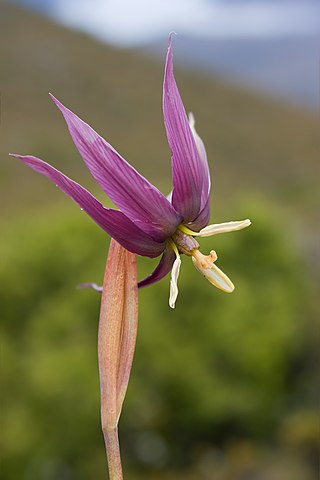
Isophysis is a genus of herbaceous, perennial and rhizomatous plants in the Iris family (Iridaceae). A monotypic genus formerly known as Hewardia, it contains a single species, Isophysis tasmanica is a Palaeoendemic found only in the south-west of Tasmania.

Solenomelus is a genus of South American species of flowering plants in the family Iridaceae. They are very closely allied to Sisyrinchium with rhizomes, flowers with a perianth tube and a style that is not divided and a single capitate stigma. The genus name is derived from the Greek words solen, meaning "tube", and melos, meaning "member".

Aristea ecklonii is a plant species in the Iridaceae, first described in 1866. It is native to central and southern Africa from South Africa north to Cameroon and Tanzania. The plant is an evergreen perennial with small, blue flowers, growing in clumps with upright, grass-like leaves 15–18 in (38–46 cm) in height.

Iris tuberosa is a species of tuberous flowering plant of the genus Iris, with the common names snake's-head, snake's-head iris, widow iris, black iris, or velvet flower-de-luce.

Sisyrinchium micranthum, commonly known as annual blue-eyed grass,blue pigroot, fairy stars, and striped rush-leaf, is a wildflower. It is a grass-like species in the iris family, Iridaceae. It is native to Mexico, Central America, and South America and widely naturalized elsewhere. The flowers are between 10 and 20 mm in diameter. Often the flowers are white with blue to purple centers, but may bloom in other colors such as yellow, pink, or violet. These are followed by rounded 3 to 8 mm brown capsules that enclose the dark brown seeds.
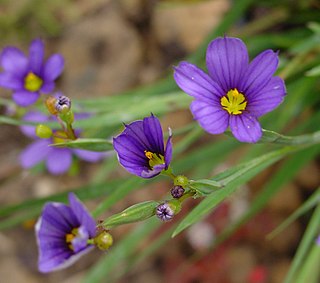
Sisyrinchium bermudiana, known as Bermudiana or, along with other members of the genus, as blue-eyed grass, is a flower of the genus Sisyrinchium that is native to the Atlantic archipelago, and British Overseas Territory, of Bermuda and the island of Ireland. The plant appears and blooms in the spring. It has been used as a totemic flower by Bermudians, and appears in art, jewellery, banknotes and elsewhere.
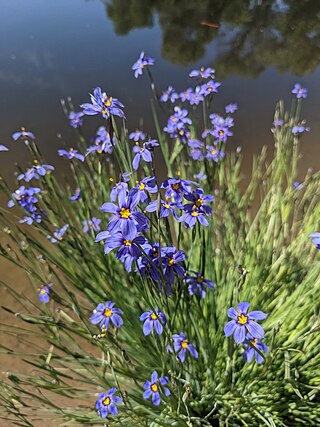
Sisyrinchium demissum, commonly called stiff blue-eyed grass is small member of the iris family in genus Sisyrinchium. The plant's natural range is in the western United states and northern Mexico. It is sometimes grown in garden settings in its native range.

